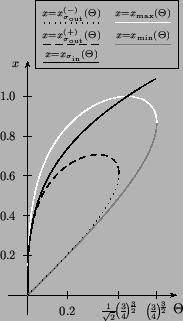The ``graphical'' analysis of the classical dynamics performed in
section 3 is based on the plot of figure 5.
In the discussion a relevant point is the sign of
![]() and
and
![]() , which is crucial in
determining the direction of the normal to the shell pointing in
the direction of increasing radius as well as the side of the Penrose diagram
crossed by the trajectory. We will show here that the situation analyzed for
the particular value
, which is crucial in
determining the direction of the normal to the shell pointing in
the direction of increasing radius as well as the side of the Penrose diagram
crossed by the trajectory. We will show here that the situation analyzed for
the particular value ![]() is, in fact, general. The sign of
is, in fact, general. The sign of
![]() is given (18), so that we see
that is positive for
is given (18), so that we see
that is positive for
 |
||
|
Figure 14: Graph of the curves that
helps in determining the sign of
|
||